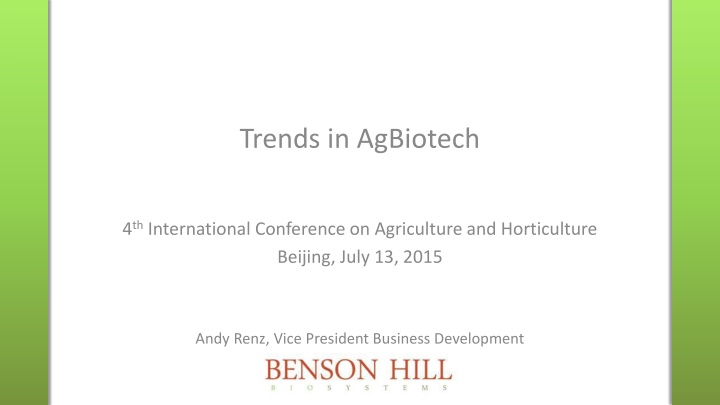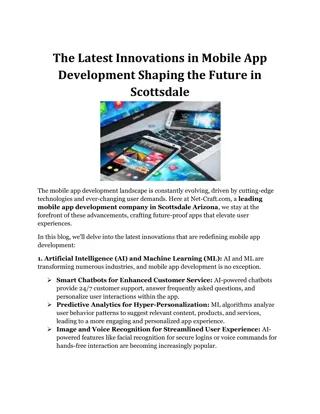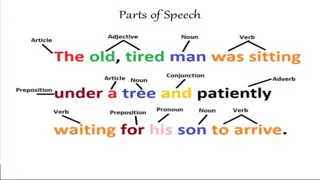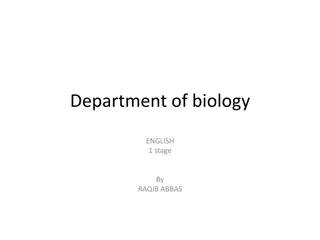Trends in AgBiotech: Past, Present, and Future Innovations
In the realm of agricultural biotechnology, advancements have been seen in both the past and present, with a look towards future trends. The 1st and 2nd generations of ag biotech, breakthrough technologies, and the high penetration rate of GM traits for major crops globally have shaped the landscape. From Bt and herbicide tolerance to complex quality traits and precision agriculture, the industry continues to evolve to meet the rising demands for increased productivity driven by factors like population growth and limited arable land.
Download Presentation

Please find below an Image/Link to download the presentation.
The content on the website is provided AS IS for your information and personal use only. It may not be sold, licensed, or shared on other websites without obtaining consent from the author.If you encounter any issues during the download, it is possible that the publisher has removed the file from their server.
You are allowed to download the files provided on this website for personal or commercial use, subject to the condition that they are used lawfully. All files are the property of their respective owners.
The content on the website is provided AS IS for your information and personal use only. It may not be sold, licensed, or shared on other websites without obtaining consent from the author.
E N D
Presentation Transcript
Trends in AgBiotech 4thInternational Conference on Agriculture and Horticulture Beijing, July 13, 2015 Andy Renz, Vice President Business Development
Overview Scope 1stGeneration ag biotech Bt & HT The Challenge: feed the world 2ndGeneration ag biotech complex traits Disease resistance Complex quality traits Abiotic stress tolerance and yield improvement Biologicals rise from a niche product to a key market Breakthrough technologies The sequencing revolution Molecular breeding Phenotyping and big data integration Genome editing Future Trends Precision Crops Plant-microbiome interactions
Scope Ag Biotech in the Past and Today 2020 Consortia biologicals Genome editing Modern breeding 1 Sprayable RNAi Complex quality traits Yield increase Single-strain biologicals Precision agriculture Stress tolerance Synthetic biology 2010 Multigene stacks (HT/IR) Disease resistance Biological plant growth regulators Herbicide tolerance 2000 Roundup Ready Bt 1990 Plant transformation
1st Generation Ag Biotech Bt and Herbicide Tolerance (HT) 1994: Calgene s FlavrSavr tomato received FDA approval 1996-2013: from 1.7 to 175 million hectars GM crops world wide; all Bt and HT Single-gene traits; no or not much interference with crop metabolism Today: Multi-gene stacks of Bt and HT
High Penetration Rate of GM Traits for Major Crops Worldwide Projected future biotech crops: (millions of acres annually) 400 Conventional 350 Wheat (544) Rice (406) Sugarcane (63) Potato (48) Eucalyptus (47) Tomato (12) Biotech 300 Millions of acres 250 200 150 100 Note: Sugarbeet and alfalfa hold >90% and >10% market penetration on U.S. acreage, respectively, but each constitute <1% of worldwide production. Small acreages of papaya, squash, and poplar are also grown. 50 0 Cotton 82% Soybean 75% Maize 32% Canola 26% Source: Clive James, 2012
The Challenge and Innovation Driver: 100% Increase in Productivity Required by 2050 Rapidly growing world population Growing middle class Higher meat consumption Biofuels production Limited arable land Ray et al, 2013, PLoS ONE Required yield increases are significantly higher than historical yield increases.
2nd Generation Ag Biotech Disease Resistance Syngenta & Monsanto: GM wheat programs in late 90 s BASF s Phytophtera resistant potato Fortuna approved, but finally shelfed 2 resistance genes from a wild potato variety introduced via GM-technology Strong resistance & good agronomic performance So far most fungal disease resistance programs are non-GM through breeding In development: GM soybean resistant against Asian Soybean Rust Disease resistant corn plants
2nd Generation Ag Biotech Complex Quality Traits Golden rice (IRRI) Humanitarian project: -carotene rice Long R&D timelines Healthy fatty acids from canola (BASF) Production of LC-PUFAs in canola through metabolic engineering of an entire pathway (8 genes!) Much more complicated than anticipated Complex interactions with crop metabolism Metabolic engineering & synthetic biology enabled Note: most other GM quality traits were discontinued
2nd Generation Ag Biotech Abiotic Stress Tolerance & Yield Increase 2025 2nd generation traits 1st generation traits, currently $12B market Yield traits represent the largest opportunity in ag biotech
2nd Generation Ag Biotech Abiotic Stress Tolerance & Yield Increase Excellent results and products from molecular breeding AQUAmax corn from Pioneer Artesian corn from Syngenta Droght tolerant rice from IRRI Opportunity and Challenge for GM approaches: Monsanto/BASF: largest partnership in the history of Ag Biotech R&D: $2.5 billion(!) HTP screens in model and crop plats Field testing in crops (commercial germplasm) First prducts: Droughtgard corn launched in 2013 (Cspb) Benson Hill Biosystems: Focus on yield improvement through improved photosynthesis
Biologicals From a Niche Product to a Key Market Enormous growth of market volume and capital invested 2012: $1.6 billion 2016: $3.2 billion Major investments & acquisitions in past years: Bayer: Athenix & Agraquest Syngenta: Pasteuria BASF: Becker Underwood Monsanto Novozymes (BioAg Alliance) Independent player: Source: Lux Research, INC. Sprayable RNAi Monsanto s BioDirect Technology
Breakthrough Technologies Based on the Sequencing Revolution Sequencing costs per genome are 10,000X lower compared to 15 years ago Enabled Molecular Breeding: Genotyping by Sequencing (GBS) Transcriptomics (RNAseq) Genomic Selection Predict phenotypes in breeding and hybrid production Much more advanced in cattle than in crops
Breakthrough Technologies Phenotyping: from Indoors to the Field State-of-the-art: automized phenotyping CropDesign/BASF Monsanto, Syngenta, Pioneer Keygene/LemnaTech (Phenolab) Donald Danforth Plant Science Center Photosynthetic Phenometrics (Michigan State Univrersity) Field-based Phenotyoping CSIRO s Phenomobile Huazhong Agricultural University University of Nebraska Lincoln
Breakthrough Technologies Aerial Imaging and Big Data Integration Aerial Imaging Drones, fixed-wing planes and multi-copters Multiple sensors: RGB, LiDAR, Thermal IR, Hyperspectral Imaging Environmental Data Weather data Soil data Big Data Integration Climate Corp/Monsanto Many others
Breakthrough Technologies Genome Editing ZFNs: Sangamo & Dow Agrosciences Meganucleases: Precision Biosciences, Cellectis TALENs: 2Blades Foundation, Calyxt CRISPR/Cas: Technology of the year 2014: CRISPR Craze DNA encoded, RNA mediated Versatile Precise Proof-of-concept in plants Complicated patent portfolio; Calyxt holds certain rights in plants
Future Trends From Isolated Silos to Integrated Approaches Molecular breeding Genomic selection Advanced phenotyping Genome editing Advanced mutagenesis Biologics Multi-genic GM traits (Yield) 2nd Generation GM traits (FR, Yield) 1st Generation single-gene GM Traits (HT, IR)
Future Trends From Isolated Silos to Integrated Approaches Molecular breeding Genomic selection Advanced phenotyping Genome editing Advanced mutagenesis Biologics Multi-genic GM traits (Yield) 2nd Generation GM traits (FR, Yield) 1st Generation single-gene GM Traits (HT, IR) In the future, more integrated approaches will increase the innovation potential.
Future Trends Integrated discovery platforms Combining molecular breeding, multi-gene traits & genome editing Proof-of-concept for functional traits through genome editing Precision crops Targeted integration for up- and down-regulation of genes GM and non-GM products based on genome editing Li et al (2013) Nature Biotechnology 30: 390-392 Crop-microbiome Interactions Formulations of biologicals with agrochemicals s proprietary Advanced Microbial Selection system
Quality improved precision crops Yield 2030 Integrated products for improved crop- microbiome interactions increased precision crops Combined biologicals products 2020 Consortia biologicals Genome editing Modern breeding Sprayable RNAi Complex quality traits Yield increase Single-strain biologicals Precision agriculture Stress tolerance Synthetic biology 2010 Multigene stacks (HT/IR) Disease resistance Biological plant growth regulators Herbicide tolerance 2000 Roundup Ready Bt 1990 Plant transformation























